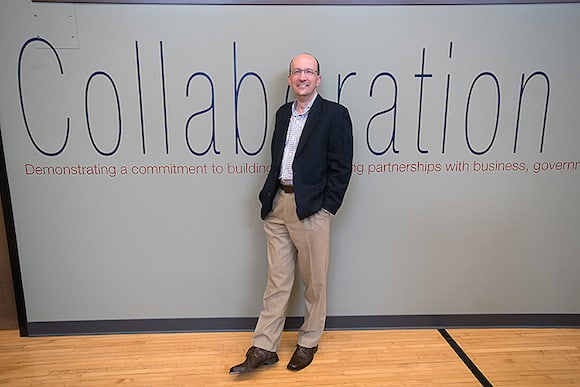On a regular day inside any Michigan nonprofit, from huge hospitals to tiny foundations, business as usual is exactly that: business. Staff members make purchases and pay bills. Funds for services, goods, sponsorships or donations are received. Employees receive their paychecks.

Jeff Williams & Joan Bowman at the Michigan Nonprofit Association -Photo Dave Trumpie

Joan Bowman

Jeff Williams

Michigan Nonprofit Association
“People normally think of nonprofits for their community benefits and their human benefits,” says Joan Bowman, senior director of public affairs and communication for the Michigan Nonprofit Association. “They just don’t realize what a strong economic impact the nonprofit sector has in the state.”
There is a huge nonprofit sector that is beneath the waves that we don’t see.
And yet, unlike with private businesses, entities like the Bureau of Labor Statistics don’t break nonprofit economic data out by industry. There used to be no way to monitor or measure what that economic activity meant for communities. That big data gap leads to a public awareness gap, says Jeff Williams, CEO of Public Sector Consultants.
“A lot of people don’t know the breadth of the nonprofit sector,” Williams says. “It’s kind of like an iceberg. There is a huge nonprofit sector that is beneath the waves that we don’t see.”
To expose the hidden economic power of nonprofits in Michigan, PSC took on the job of digging up the data themselves. What PSC has found by tracking the industry since 1999 is just how economically powerful Michigan’s nonprofits truly are.
A workforce workhorse sector
According to PSC’s most recent data, there are more than 47,000 nonprofits in Michigan. That adds up to a lot of positive economic impact on communities across the state. For example, more than 440,000 people are employed in Michigan nonprofits.
“That’s basically 10 percent of the state’s workforce,” says Williams.
Providing jobs is a big deal — especially when you can quantify their impact. The data shows nonprofit payroll in Michigan is about $5 billion a quarter. According to Michigan Labor Market Information, the Michigan 2015 Occupational Wages Estimates/All Industries data says total estimated employment was 4,146,600 and the average wage was $46,310, for a total of about $48 billion per quarter. Every three months, that’s money being spent in grocery stores, gas stations and housing, among other expenses. Even better, says Bowman, those jobs and earnings didn’t take a hit during the recession the way the private sector did.
“Nonprofits remained stable at a time when much of Michigan’s economy declined significantly,” says Bowman. Those dollars flowing into private businesses were critical, especially when the economy was struggling.
Big spenders for public good
Nonprofits don’t just pay for labor, though.
“Many nonprofits operate just like a small business,” Bowman says. “They have money. They have vendors. They buy supplies. They make a significant, direct contribution to the economy.”
How significant? Michigan nonprofits actually spend about $80 billion a year. From party supplies to Band-Aids, that money is spent in and spread throughout the economy. And those dollars even go a little further for Michigan residents than spending from private organizations.
“That intersection of volunteerism and philanthropy is a little bit different in the nonprofit sector,” says Bowman.
After all, a donor to a nonprofit can receive a tax deduction for their gift. Then, the nonprofit is exempt from some types of taxes, so more of those funds stay within the organization to help it pursue its mission — typically providing a community benefit. That’s not to mention how many nonprofits leverage volunteers to get the most service possible from every dollar spent.
The power of measuring nonprofits
The economic impact of Michigan nonprofits may be impressive, but why does it matter? PSC doesn’t take the time to compile it for nothing. Data is powerful, and it helps nonprofits grow their economic impact and further their mission.
For example, Williams recalls an instance when state funding for an arts grant was nearly cut from the budget. Arts-based nonprofits were able to show how 60 to 70 percent of total spending in some regions of Michigan would have been eliminated without it. While the funding was reduced, it wasn’t eliminated as originally intended.
“To the state, that spending was tiny. But to the communities receiving this grant,” he says, “if they took that grant away, it could cut off spending for arts and the humanities in that area.”
Nonprofits also use the data when applying for grants. Organizations that make grants use it as well to determine funding and service needs in a particular area. Legislative analysts use the data to help government and nonprofits work together better. Policymakers leverage the information to guide public policy.
And because of the lack of government statistics on nonprofits, Michigan is one of few states that reap those benefits.
“At best, this data is spotty across the nation,” says Williams. “In other states, the information simply doesn’t exist.”
From jobs to spending, having access to that data unlocks some pretty powerful truths about nonprofits. Not only is the economic impact of Michigan’s nonprofit sector big, but the ability to quantify that impact helps it — and the nonprofits themselves — grow stronger.
This piece was made possible through a partnership with Public Sector Consultants.
Photos © Dave Trumpie
Dave Trumpie is the managing photographer for Capital Gains. He is a freelance photographer and owner of Trumpie Photography.
This article originally appeared in Capital Gains, an online magazine and website showcasing the growth and investments transforming the Lansing region, on July 27, 2016.
